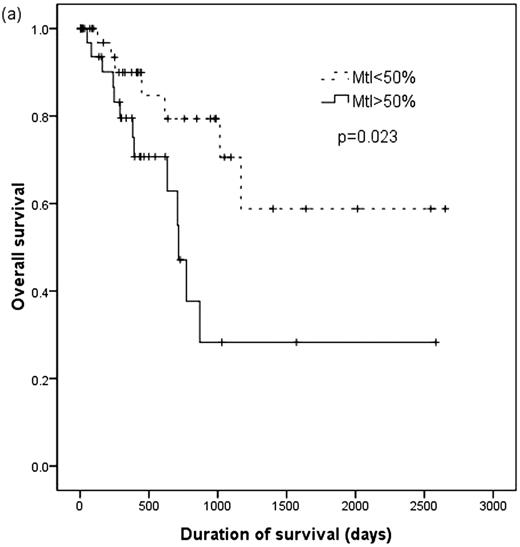Abstract
Abstract 3793
Poster Board III-729
The inactivation of tumor suppressor genes by promotor hypermethylation, particularly p15INK4b, is believed to contribute to the initiation and the progression of myelodysplastic syndromes (MDS). p15INK4b methylation was found to be more frequent in high-risk MDS (RAEB) at the time of diagnosis, and to be associated with progression to AML in the studies using methylation-specific PCR (MSPCR). We investigated if the quantity of p15INK4b methylation is related to International Prognosic Scoring System variables (IPSS) and survival in the myelodysplastic syndrome (MDS) patients and if the quantity of p15INK4b methylation reflects the bone marrow status (the percentage of blasts or the degree of dysplasia) of the patients under treatment with or without hypomethylating agents.
The study included 74 de novo MDS patients including 24 with follow-up bone marrow examination: 10 under treatment with hypomethylating agent and 14 under treatment with other than hypomethylating agent including stem cell transplantation (SCT). We pyrosequenced 63 base pairs of p15INK4b including 11 CpGs using PSQ96MA system (Biotage, Uppsala, Sweden), with the extent of CpG cytosine methylation assessed in terms of methylation index (MtI) and methylation level (MtL).
Patients with >5% bone marrow blasts had higher MtI and MtL (58.8% and 10.1%, respectively) than patients with <5% blasts (44.0% and 6.1%, p = 0.031 and p = 0.030, respectively). Methylation quantity was not associated with chromosomal aberrations. The MtI and MtL of patients with thrombocytopenia were higher than patients without thrombocytopenia (62.1% vs. 44.1%, p = 0.009, and 11.2% vs. 6.2%, p = 0.036, respectively); they were higher in patients with cytopenias in °Ã2 lineages than in patients with either unilineage or no cytopenia (56.5% vs. 39.4%, p = 0.055, and 9.8% vs. 4.1%, p = 0.036, respectively). The survival of patients with >50% MtI or >7% MtL was worse than patients with <50% MtI or <7% MtL (p = 0.023 and p = 0.031, respectively). Methylation quantity of p15INK4b did not correlate with the bone marrow status of the patients under treatment regardless of using hypomethylating agent or not.
Using pyrosequencing, we showed that the quantity of p15INK4b methylation correlates with thrombocytopenia and blast percentage in MDS patients. Heavy p15INK4b methylation in MDS is associated with adverse survival. Methylation quantity of p15INK4b did not appear to reflect the bone marrow status of the patients under treatment regardless of the use of hypomethylating agent in this study, however, further study with controlled patient group is required to clarify this issue.
Fig. 1. Heavy methylation of the p15INK4b promotor region is a prognostic factor for poor survival in MDS patients. (a) Kaplan-Meier curves of MDS patients with MtI >50% and patients with MtI <50% (mean survival time: 1118 days vs. 1864 days, respectively). (b) MDS patients with MtL >7% and patients with MtL <7% (738 days vs. 1804 days, respectively).
No relevant conflicts of interest to declare.
Author notes
Asterisk with author names denotes non-ASH members.



This feature is available to Subscribers Only
Sign In or Create an Account Close Modal